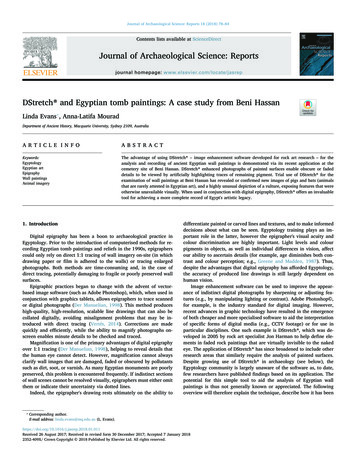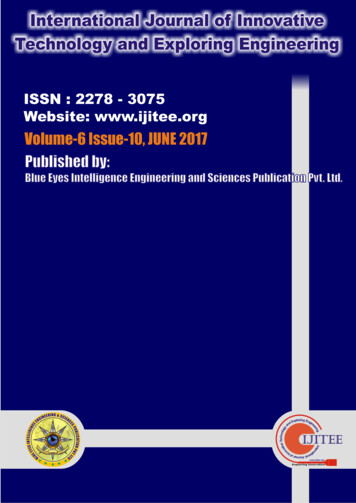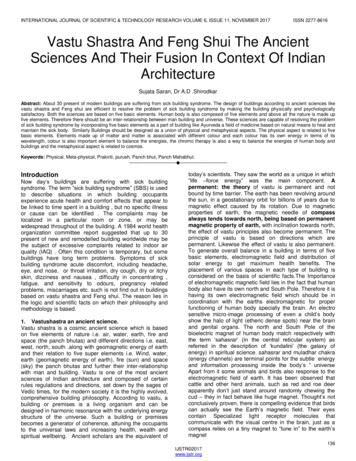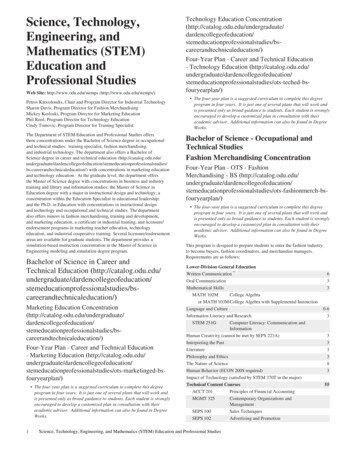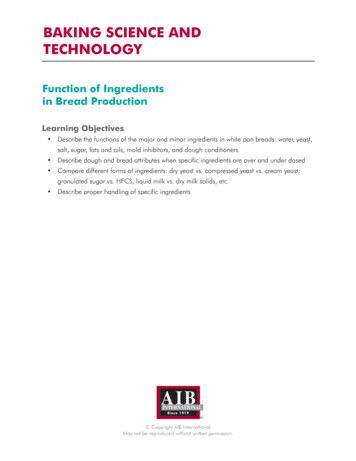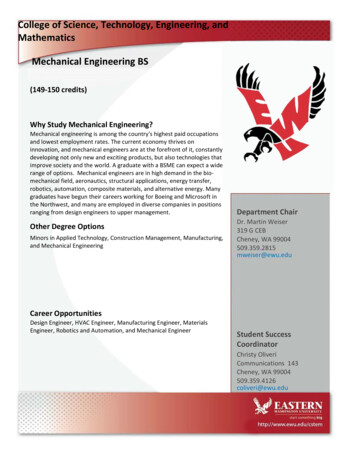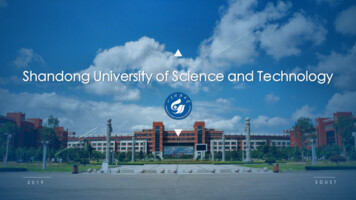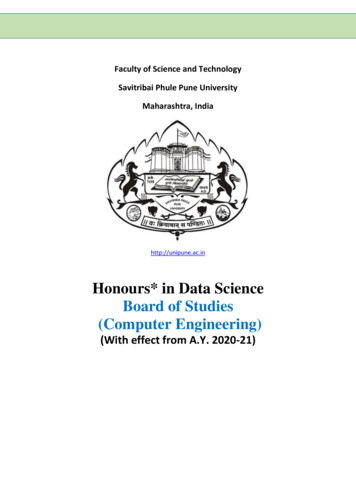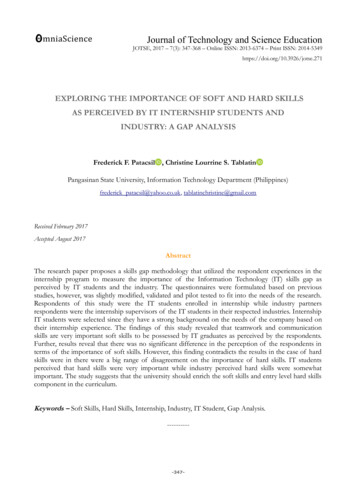
Transcription
Journal of Technology and Science EducationJOTSE, 2017 – 7(3): 347-368 – Online ISSN: 2013-6374 – Print ISSN: G THE IMPORTANCE OF SOFT AND HARD SKILLSAS PERCEIVED BY IT INTERNSHIP STUDENTS ANDINDUSTRY: A GAP ANALYSISFrederick F. Patacsil , Christine Lourrine S. TablatinPangasinan State University, Information Technology Department (Philippines)frederick patacsil@yahoo.co.uk, tablatinchristine@gmail.comReceived February 2017Accepted August 2017AbstractThe research paper proposes a skills gap methodology that utilized the respondent experiences in theinternship program to measure the importance of the Information Technology (IT) skills gap asperceived by IT students and the industry. The questionnaires were formulated based on previousstudies, however, was slightly modified, validated and pilot tested to fit into the needs of the research.Respondents of this study were the IT students enrolled in internship while industry partnersrespondents were the internship supervisors of the IT students in their respected industries. InternshipIT students were selected since they have a strong background on the needs of the company based ontheir internship experience. The findings of this study revealed that teamwork and communicationskills are very important soft skills to be possessed by IT graduates as perceived by the respondents.Further, results reveal that there was no significant difference in the perception of the respondents interms of the importance of soft skills. However, this finding contradicts the results in the case of hardskills were in there were a big range of disagreement on the importance of hard skills. IT studentsperceived that hard skills were very important while industry perceived hard skills were somewhatimportant. The study suggests that the university should enrich the soft skills and entry level hard skillscomponent in the curriculum.Keywords – Soft Skills, Hard Skills, Internship, Industry, IT Student, Gap Analysis.-----------347-
Journal of Technology and Science Education – https://doi.org/10.3926/jotse.2711. IntroductionThe role of Information Technology (IT) professionals in the industries and organizations hasexpanded much over the past years. From basic encoding of business transactions and generationof reports, IT has stretched on to becoming an important means for software and applicationdevelopment, network engineering and maintenance, and more recently, call centers, medical andlegal transcription, animation, and various forms of business process outsourcing. In short, it iswidely applicable in all sectors of industry (Sipin, Lloyd & Malabanan 2014). IT is anotherevolving high-skills field that needs qualified workers to keep pace with its ongoing change.According to CompTIA, “more than 15 million businesses rate the aggregate skill levels of theirIT staff as less than optimal, and 93 percent of employers indicate that there is an overall skillsgap among employees” (American Society for Training and Development, 2012).In a world where IT knowledge and skills are critical elements for nations to prosper andcompete, primacy is placed on the quality and relevance of education and how to ensure thatgraduates have sufficient knowledge, skills, attitudes, and values to meet the demands of theindustries. The changing nature of work environments, the emergence of technology-drivenprocesses, and the diversified needs of clientele are the emerging challenges of Higher EducationInstitutions (HEIs) in order to meet the demand for employable graduates (Same Inanotech,2014). Moreover, Silicon Valley-trained Filipino software gurus said that “only 10 percent ofinformation technology or computer science graduates are hireable” – a reflection of the sorrystate of the country’s IT education. In 2011, the country produced 70,000 graduates of computerscience, IT and related courses. From this figure, only 0.25 percent meet the needs of the globalindustries and this can be reversed given the number of potential talents that the country canhave (Cuevas-Miel, 2012). Thus, becoming a critical concern for universities and colleges. This isan indication that Higher Education Institutions are challenged to equip their graduates withmore than just academic skills (Singh & Singh, 2008). Nevertheless, graduates are expected todevelop personal skills, qualities, and experiences that will enable them to compete in the labormarket (Alsafadi & Abunafesa, 2012).Skills gap is a major issue in the Philippines. In the Asian Development Outlook 2016, it wasfound that Filipino college graduates took about a year to find a work while high schoolgraduates fared even worse, taking up to three years to do so. A main reason for the skills gap isthat many of the graduates are not equipped with industry-relevant skills, especially in industriesrelated to science and technology. Both public and private schools are facing challenges in-348-
Journal of Technology and Science Education – https://doi.org/10.3926/jotse.271producing graduates who can meet industry demands (Song & Tang, 2016). Among the basicskills gap problems faced are seen throughout the economy: underdeveloped state of skillstraining system in the public schools, outdated curriculum, insufficient dialogue and coordinationamongst the stakeholders regarding skills needs and training, inadequate accreditation of trainingprograms, and scant avenues for re-skilling. The Commission on Higher Education (CHED)came out with an intervention. To address this gap problem an On the Job Training (OJT) orinternship program to fill in the gap between academic acquired skills and practical skillsknowledge needed by the industry. Policies and standard are adopted by the commission torationalization of Information Technology Education (ITE) in the country and keep pace withthe demands of global competitiveness. In the policies and standard, internship is included andexpanded as a requirement for the BSIT and BSIS programs which aims was to give students thechance and opportunity to immerse the IT industries. Through the internship program, studentswill have the chance to apply the skills, knowledge and attitude learned in the school and at thesame time the opportunity to experience the corporate environment.In addition, through internship, students are given the opportunity to observe and apply the bestpractice the best trade to self-generate the skills necessary for this occupation (Sides & Mrvica,2007). Since, the internship program is an academic activity often as a good venue to analyze thegap between the skills learned from the school and the industries can use as a baseline inenhancing the IT curriculum and improving the delivery of instruction.In that context, this research examined the importance of soft and hard skills as perceived by theindustry partners and IT students. Further, to considered possible solutions for bridging theperceived skill gap. Specifically, it answers the following: To determine the most important employable soft and hard skills as perceived by theindustry partners and IT intership students; To determine if there are differences in the importance of various employable skills asperceived by the industry partners and IT intership students; and To recommend possible solutions to bridge the skill gap.-349-
Journal of Technology and Science Education – https://doi.org/10.3926/jotse.2712. Related Literature and Studies“Skills refer to the level of performance of an individual on a particular task or the capability toperform a job well which can be divided into technical elements and behavioral elements” (Noe,Hollenbeck & Gerhart, 2015). Technical elements measure “HARD” technical skills while thecommunication elements measure “soft” skills which include the attitudes and approachesapplicants take to their work, such as the ability to collaborate on team projects (Daud, Abidin,Sapuan & Rajadurai, 2012). Skills gap is defined “as the difference between the markets need(demand) and the current skills supplied by local education institutes (supply)” (Alsafadi &Abunafesa, 2012). In this context, students should be aware of the needs and relate their abilitiesto be able them to meet the requirement of their future by employers (Yorke & Harvey, 2002). Ifstudents do not see the need and the importance of IT skills, the likelihood of higher educationinstitutions managing to convince students to instill the desired competencies will be difficult(Coll, Zegward & Hodges, 2002).Parsons trait and factor theory operate under the premise that it is possible to measure bothindividual skills, talents and the attributes required in particular jobs. It also assumes that peoplemay be matched to an occupation that will fit into them. Therefore, if the ability of the individualsuited to the job, they will perform best and their productivity will be at the highest (Careersnz,2016). In addition, Barnard, Veldhuis & Van Rooij (2001) job-matching theory claims that theforemost goal of education is to prepare the instilling graduate appropriate skills for the tasksthey will go to perform in their future jobs. The theory asserts that a mismatch between therequired skills and the skills a graduate actually possesses has a significant contribution in theirproductivity, wages and probability get a job. Therefore, the skills required by employers must beequivalent with the skills of the graduates. The challenge therefore is to enable students realizehow importance generic competencies, how these aligned skills improve their employmentopportunities in a highly competitive market and that they should take ownership of these(Maher & Graves, 2008).National Workforce Center for Emerging Technologies (NWCET) identified IT career clustersthat have been broadly adopted by industry, education, and government policymakers as astandard framework for classifying IT jobs and careers and for quantifying their supply anddemand. The cluster is presented in the IT skills Pyramid as shown in Figure 1.-350-
Journal of Technology and Science Education – https://doi.org/10.3926/jotse.271Figure 1. The IT Skills PyramidThe three-tiered pyramid depicts IT skill standards in 3 broad IT skill categories: foundation andemployability skills, common technical skills, and industry-specific technical skills andorganizational knowledge.Tier 1 is the set of foundational and employability skills, knowledge, and abilities that are requiredto all information worker employees. These are the universal skills—problem solving, team skills,and flexibility—that are needed to apply technical knowledge and tools effectively.Tier 2 is the set of technical skills, knowledge, and abilities common to all IT positions within anIT career cluster.Tier 3 is the set of industry-specific technical skills, knowledge, and abilities that are unique toindividual clusters and that are the most susceptible to change.-351-
Journal of Technology and Science Education – https://doi.org/10.3926/jotse.271This study focuses on the tier 1 and tier 2 since both are employability skills and generalrequirements associated with the function or task required for a new IT graduate. Input fromindustry clearly shows that without solid mastery of this employability skills, a graduate cannotsucceed in the highly competitive work environment. In addition, employers often say that“technical skills are attributes that may land graduate to a job, but foundation skills make them avalued employee and significantly increase their career advancement”.2.1. Skill gaps input to curriculum enhancementThe development of an individual's knowledge, skills, and attitudes is not just the soleresponsibility of the academic community; nevertheless, it is a join responsibility of the students,school and industry.In a congruent study conducted by Radermacher, Walia and Knudson (2014) which intended toassist educators in identifying areas where students may not measure up the expectations ofindustry companies and in improving the curriculum at their universities to better prepare themfor their future careers. In this study, the respondents were asked questions about what particularskills where recent graduates frequently struggled when they started their employment at theircompanies and which particular skill deficiencies might prevent a recent graduate from beinghired.The study of Scott, Alger, Pequeno and Sessions (2002) revealed that there was alignmentbetween the importance rating of industry and the skills of students in some areas. Althoughthere are correlation exists on the specific skills that industry requires and those which studentspossess, however, there are knowledge of certain technical and technological skills that are stilllacking from the formal Information System (IS) curriculum.Shariff, Kayat and Abidin (2014) and McMurtrey, Downey, Zeltmann and Friedman (2008)shown that their findings were used to assist the academic institutions in the process of designingthe curriculum as to meet the industry needs and suggest that revision should be consulted andparticipated by industry partners. Another study conducted by Zaharim, Omar, Basri and ISA(2009) utilized the outcomes of their study to revise guideline for the engineering educationcurricula of Malaysian Institutions of Higher Learning. In all of these studies, both the academiccommunity and industry partners play important roles in providing needed information aboutskill gaps in the key industrial work areas. To achieve this, it needs to establish mechanisms for-352-
Journal of Technology and Science Education – https://doi.org/10.3926/jotse.271active, structured and meaningful consultation with industry partners on a regular basis throughOJT or Internship. The researchers believe that this research will surely provide academiccommunity and the industry with more knowledge to obtain more effective collaboration so thatit will be helpful to both academic ad industry.2.2. Soft SkillsSeveral researchers investigated numerous ways in which recently graduated students strugglewhen they started their first jobs. There are 10 commonly noted soft skills related to jobs in thefields of business and computer technology were communications, critical and decision-making,interpersonal, negotiation, problem solving, self-confidence, self-management, teamwork andworth ethics (Williams, 2015; Singh & Singh, 2008; Pritchard, 2013; Robles, 2012; Bringula,Balcoba & Basa, 2016; Ajzen, 1991). A study conducted by Williams (2015) directly affectspositive social change of college students by enhancing the quality of soft skills for their futureemployees. The study revealed that key soft skills communication skills were the most relevant,and the skills most students needed to improve. Although other skills–negotiation and criticalthinking skills–needed improvement, they were not as crucial at the entry-level status suitable forthe community college students. In addition, a professional development training program whereproposed to help students enhance their soft skills before entering their future careers. Anotherstudy by Radermacher et al. (2014) indicated that recent graduates struggle communicating withco-workers and customers. Therefore, their study proposed that that the academic communityshould make sure that students will have effective problem solving and effective communicationskills.Noll and Wilkins (2002) utilized a survey instrument asking respondents to rate the importanceof each knowledge/skill areas from each of the staffing groups. The results show that ISknowledge relating to the entire organization and overall business knowledge is important,however the so-called ‘soft skills’ such as teamwork and collaboration, planning and leadingprojects, presentation delivery, and writing skills will be critical for success in the IS profession.In addition, the results of the study show that there is a need to enhance the quality of soft skillsfor future employees who enter the local workforce and soft skills are perceived by students andemployers as relevant employability skills (Ajzen, 1991; Singh & Singh, 2008; Robles, 2012;Pritchard, 2013; Goswami, 2013; Williams, 2015; Bringula, Balcoba & Basa, 2016). These-353-
Journal of Technology and Science Education – https://doi.org/10.3926/jotse.271previous studies bring to light the importance of soft skills for professional growth and technicalskills alone are not sufficient for success in the IT profession - soft skills like communication,problem solving, and teamwork are increasingly important.The study consequently tried to confirm whether academic acquire soft skills of our studentsneed to be enhanced based on the performance of IT students as observed by their intershipsupervisors. Likewise, the results of this investigation will try to prove that, overall, IT studentsand industry partners viewed soft skills equally important as technical skills for the successfulintegration of entry-level employees. In addition, the study tried to determine the most importantsoft skill an IT graduate should possess using different research respondents, culture, industryand the venue including the difference in the results as compared to the previous studies.2.3. Hard SkillsThese skills are used as a basis for the development of educational curriculum, future profilingof jobs and the technical functions that the industry desire most (Kennedy, 2016). InformationTechnology (IT) may be the most challenging program in terms of skill gaps due to the fast paceof change in terms of hardware and software development. Nevertheless, according to Pritchard(2013) entry-level skills if posses by the student can provide long-term careers. It is important tonote that very few ICT occupations are “low skill” and that the entry point for ICT career latticesis considerably higher than that in other program. According to Work2future Skills Gap Analysis(2013) entry-level ICT occupations are computer operators, Computer User Support Specialists,Computer Network Support Specialists, Network and Computer Systems Administrators,Computer Systems Analysts and Database Administrators. The study further suggests thateducational institutions should focus on strengthening the skills of their students in these areas.An empirical investigation conducted by Medlin, Schneberger and Hunsinger (2007) tries todetermine IT students view on the IT technical skills necessary to be a successful IT professionaland how well their perceptions match those IT technical skills actually sought in IT online jobadvertisements. The result of their study finds several gaps that exist between studentperceptions of the skills they need versus the actual IT skills employers are advertising.This study utilized the concept of entry level hard skills as discussed by NWCET and ICToccupations “low skill” of Work2future Skills and the following technical skills are knowledge ofstandard software applications, knowledge of programming languages, the ability to design user--354-
Journal of Technology and Science Education – https://doi.org/10.3926/jotse.271friendly graphical interfaces, knowledge of database, knowledge of networking, and knowledgeof computer hardware. These technical skill keywords were listed and rank by the employee asvery important ICT entry level skills. Further, the same six groups of technical skills were used inthe survey of student perceptions of skill demands used in searching job listings.The study was conducted for the following reasons which is important to both our industrypartners and to the academic communities. IT technology is rapidly developing overnight andthere should be a continuous process to determine the desirable skills of future IT professionals.Furthermore, this study concentrates solely on the required skills and their importance asperceived by our industry partners and as observed by IT intership students.The study identifies the skills
2014). Moreover, Silicon Valley-trained Filipino software gurus said that “only 10 percent of information technology or computer science graduates are hireable” – a reflection of the sorry state of the country’s IT education. In 2011, the country produced 70,0
